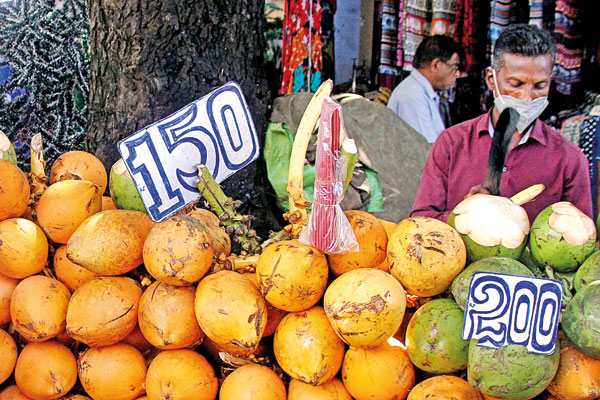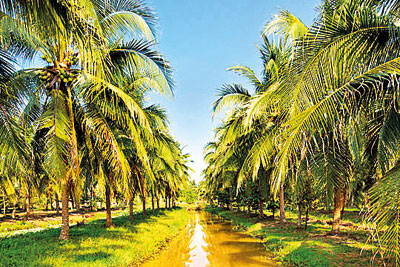News
Coconut industry in a soup: Tree of life has become ‘lazy man’s crop’ in Sri Lanka
View(s):- Expert sees poor estate management, high fertiliser, transport and machinery costs and lack of investors as key factors plaguing the industry
By Sunimalee Dias
The coconut industry in Sri Lanka lacks foreign direct investment, financial assistance and is subject to poor estate management — all matters that need to be addressed if productivity is to be improved.
The coconut tree is known as the “Tree of life” due to its versatile uses, but it is also considered the “lazy man’s crop” since in most cases, farmers especially, smallholders, just watch and wait for the produce.
There is less priority accorded to the cultivation and adoption of best practices to generate higher yields due to increased costs. Moreover, revenue from the sale of coconuts is not the sole source of income for many smallholders. As a result, there is no adequate tending to the crop to increase yields.

One of the main concerns today is the senile plantations where old palms are less productive with farmers reluctant to remove those and go for new plants due to cost factors

Prof. Lasantha Weerasinghe
Potential not fully tapped
The potential coconut yield in Sri Lanka is 20,000 nuts per hectare, but at present farmers get a low average yield of about 6,000 nuts per hectare, Professor Lasantha Weerasinghe of the department of crop science, faculty of agriculture, University of Peradeniya, told the Sunday Times.
He explained that one of the main concerns today is the senile plantations where “we have old palms that are less productive and people are reluctant to remove those and go for new plants due to cost factors”.
Experts attribute the volatility in crop production over the years to climatic conditions and a drop in fertiliser application to some extent.
Climatic conditions like rainfall are a key factor in coconut yields and in the last two years, Sri Lankan growers did not apply adequate fertiliser to the crop. The average nut production/annually is at 2,700-2,900 million nuts, of which 70% is consumed locally. Each person consumes 116 nuts per year out of which 89 is for culinary purposes, and the rest as oil.
Prof. Weerasinghe pointed out that poor estate management, the high costs of fertiliser, transport, and machinery, and people not wanting to invest more on the plantations are key issues related to improving productivity. The reduction in the income for a unit of land area is due to the low land productivity, he further noted.

Low yields have pushed up prices in the local market. Pic by Eshan Fernando
Best practices and high yielding crops
Crop diversity is not available on the plantations today and at present there are about 44-46 palms per acre whereas ideally there should be 64 palms per acre resulting in suboptimal plant density, Prof Weerasinghe said.
Measures need to be adopted to increase the income from the land by engaging in animal husbandry, intercropping, which can also increase the fertility of the land, and soil and moisture conservation. These are not effectively practiced by farmers. In fact, even on flat lands, soil erosion is prevalent, he noted.
Further, adequate fertiliser is needed to plant improved coconut plant varieties, Prof. Weerasinghe said. This can help generate high yields, but requires more nutrients to produce more.
Moreover, they need to replenish the nutrients for which more fertiliser needs to be applied, it was noted.
Prof. Weerasinghe also pointed out that organic fertiliser can help to increase the soil’s physical, chemical and biological properties to a considerable extent.
When there is a drop in production, there are fewer nuts to be picked up by the millers/processing industry which will then process them and add value for export.
Plantations run on a commercial scale, cultivation based on the typical variety that are suitable for all coconut growing areas in Sri Lanka. CRIC 65 is another high yielding variety that is ideal for home gardens where two plants are sufficient for a month’s consumption, he said. More varieties are required in the dry zone like CRIC60 and TSR (CRISL 98) type that are tall trees.
Targeting plans for 2040 would mean there needs to be an increase in high yielding varieties cultivated on the estates; and in this respect, although the CRI (Coconut Research Institute) has produced these types of coconut plant varieties farmers are, however, reluctant to practise these due to the high costs involved in cultivation and maintenance of plantations.
Crisis aggravates in state institutions
The CRI is facing a serious crisis with most researchers leaving for better prospects in other countries or opting to join local universities, Prof. Weerasinghe said.
Research is costly, but is necessary and funds are needed. Researchers face a number of other constraints. “In the US, lots of money is invested for research but in Sri Lanka we tax even for research instruments despite the limited amount of money available for research.”
Other sources point out that most state institutions like the Coconut Development Authority (CDA) and the CRI were already facing a crisis as state officials are unable to carry out their duties due to the increased political interference.
Moreover, it was pointed out that the CRI is blamed also for the lack of attention to the containment of pests, but they lack staff.
Addressing the issue of the white fly disease, Prof. Weerasinghe said that there are no reports available on substantial yield reduction. In fact, applying the chemicals for disease control can be difficult because of the height of the trees. But, measures have been introduced to control pests like the coconut black beetle and coconut red weevil.
The Government is responsible for providing facilities and appointing knowledgeable people who should be innovative and educated to head coconut sector institutes and management positions.
Subsidies a necessity
As some industry experts point out, any agricultural sector in the world requires some kind of support as this ensures food security, which is paramount.
But the issue with subsidies in Sri Lanka is that this is given totally free to all, which is mainly a politically popular with eye on success at elections.
However, subsidies should ensure farmers can purchase fertiliser at a reduced price and in this context national policy needs to be consistent. Farmers must also be asked to spend their own money as well which will ensure they are able to look after their crop better.
Subsidies need to be restarted but it must be monitored, Prof. Weerasinghe said adding that the subsidy scheme in operation for the industry was a good system.
But this has been stopped and the coconut sector does not receive any subsidy for fertilisers and as a result, smallholders in particular find it hard to compete with some of their competitor nations as the Sri Lankan nut is becoming more expensive due to increased costs and due to poor support received from the state.
In fact, some producers argue that at Rs.11,500, fertiliser is expensive but farmers must use alternatives like mulching, cattle feed and chicken dung. A clear focus on achieving a higher yield is necessary at the smallholder level; on the contrary it is the larger coconut lands that continue to retain focus on exacting a high yielding crop.
Rivals encroach on exports turf
Sri Lanka is a lost cause when it comes to attracting investments into the coconut industry whereas other competing nations have already forged ahead by attracting foreign direct investments (FDI) into a sector that is today taking a turn for the better with coconut-based products becoming a health benefit.
At present the industry’s main issue is the high domestic consumption that is overriding the entire industry requirement. Exporters say that the export market has been stagnant for the last 30 years. Moreover, if they were to meet the entire requirement for domestic and oil industry then a production of 4.5-4.6 billion nuts is required and until that gap is achieved the import of edible oil is required.
Over a 15-20 year period Sri Lanka has lost its European and West Asia markets to some of the biggest players in the industry, namely Indonesia, the Philippines and Vietnam and now India is also moving in. The Philippines and Indonesia account for nearly 60% of global coconut production by land area and as in the rest of the world these coconut estates are managed almost entirely by smallholders.
Prof. Weerasinghe explained that Sri Lanka needs to explore the Russian and Chinese markets in addition to the West Asian countries. At present Sri Lanka has access to the US and EU markets due to the GSP + concessions.
However, it is interesting to note that some of these key markets themselves are investing in the production of coconut in lands that are popular for coconut exports, like the Philippines, where US investors have established their own factories.
But this situation does not occur in Sri Lanka due to the element of nonconducive investment opportunities, corruption, along with a stringent bureaucratic administration structure, Prof. Weerainsghe said.
Sources point out that investments are turned back when faced against the iron walls of bribery and corruption by top level Government ministers.
The industry opted to set up their estates within the Mahaweli zone in Aralaganwila where coconut lands amounting to 1,600 acres in extent was operated by the private sector desiccated coconut millers alone. This ensures they have a continuous flow of nuts to the factories, exporters said, insisting that this is one way in which the industry can ensure the export market is taken care of.
In fact, educating people is relevant in today’s context so as to reduce domestic waste and ensure they purchase value added products as opposed to buying the kernel which still is more popular. But Sri Lankans neither purchase the value added products packaged and sold as liquid milk and powder nor are they interested in cultivating the crop in their gardens to ensure they produce their own requirements.
“We will not be able to reach the required level of production if the country continues to practice the current cultivation methods and just watch and wait. If an increase in production takes place by about 10 nuts more per palm/year then there can be an increase in annual yields by 440 million nuts by just applying more care and a 50:50 ratio of chemical and organic fertiliser application,” Prof. Weerasinghe explained.
He proposed that for developing and maintaining coconut lands, area based plantation management companies should be established so small-scale growers can pay and get help to maintain their lands.
Prof. Weerasinghe is confident the coconut industry will not collapse but noted that only the innovative/smart farmers/growers will be able to progress.
Sri Lanka produces a unique nut that had been popular for the desiccated coconut (DC) segment in the global market for its eco-friendly production.
But the country lost its DC market and later made gains in the coconut milk market which is now growing in popularity. This led to Sri Lanka generating US$860 million last year that contributed to an overall increase in revenues.
Exporters note that the value of coconut milk is better than the DC market since the latter is just an ingredient.
Sri Lanka has made inroads into a number of other by-products that are marketed extensively, like king coconut water, coconut milk, coconut powder, virgin coconut oil, brown fibre and desiccated coconut and is the fourth largest exporter of fresh and dried coconut products globally.
Retaining this position and ensuring the industry is sufficiently provided for by the state requires consistent policies, total engagement at the production stage by smallholders and continued awareness among people.
The auction process has to be streamlined to ensure all growers are part of the entire system with policies and laws drafted accordingly. In addition, if production should increase it will ensure that millers don’t rush to import palm oil as some do today to ensure a steady flow of nuts to their factories.
| Health claims not fully understoodIn the past, coconut oil was classified along with saturated fatty acid food items and criticised for its negative impact on health. However, research studies have shown that coconut oil is a rich source of medium-chain fatty acids.Beyond its use in cooking, coconut oil has attracted attention due to its hypocholesterolemic, anti-cancer, anti-hepatosteatotic, anti-diabetic, anti-oxidant, anti-inflammatory, anti-microbial and skin moisturising properties. Despite all the health benefits, consumption of coconut oil is still underrated due to a lack of supportive scientific evidence. Even though Asian countries claim a favourable impact on cardiac health and serum lipid profile, the limitations in the number of studies in Western countries impedes the endorsement of the real value of coconut oil.
| |
| Facts on coconutsSri Lanka has three local coconut varieties namely Typica, Nana (short in habit used for breeding), and Aurantiaca or the king coconut variety. High yielding varieties like CRIC65, Kapruwana, Kapsetha and Kapsuwaya are suitable for the wet zone.Potential yield on average should be 20,000 nuts/ha but 6,000 nuts per hectare is the current average yield. Planting density 64 palms per acre/ 158 palms per hectare.  In a healthy palm there are 30-35 leaves in a healthy crown and within a given year an adult palm produces 12-16 new leaves. With each new leaf you get coconut inflorescence. Tall varieties cross pollinate and dwarf varieties self pollinate. In a healthy palm there are 30-35 leaves in a healthy crown and within a given year an adult palm produces 12-16 new leaves. With each new leaf you get coconut inflorescence. Tall varieties cross pollinate and dwarf varieties self pollinate. Rainfall required is 1200-2000 mm/year. Prefer spread uniform rainfall throughout the year. |
The best way to say that you found the home of your dreams is by finding it on Hitad.lk. We have listings for apartments for sale or rent in Sri Lanka, no matter what locale you're looking for! Whether you live in Colombo, Galle, Kandy, Matara, Jaffna and more - we've got them all!

